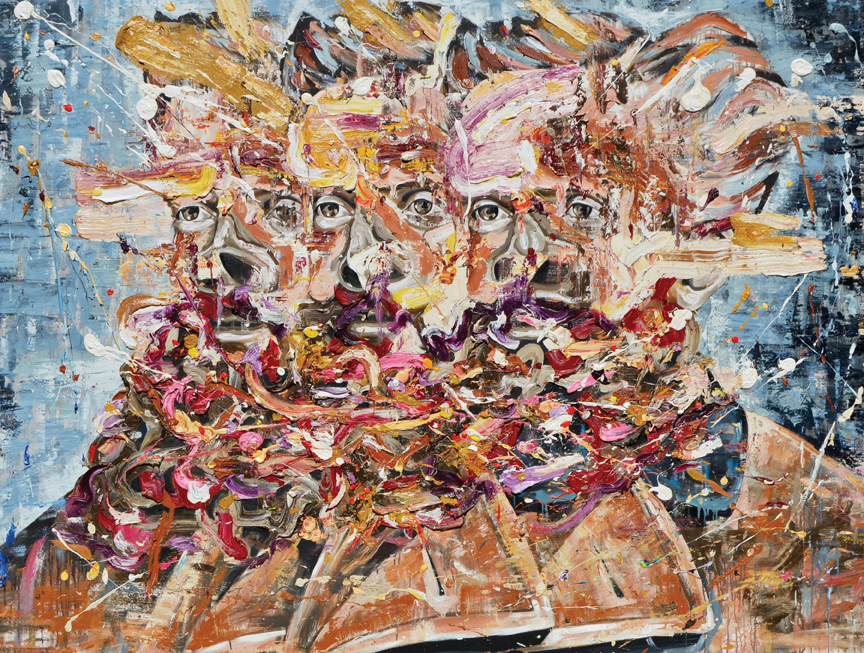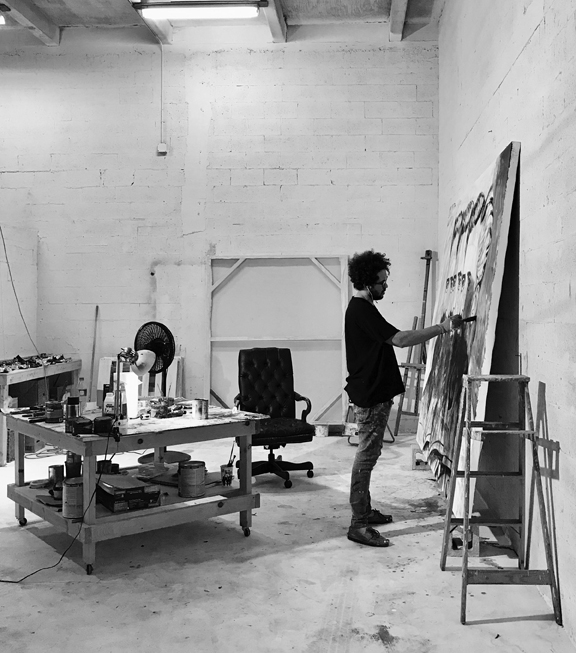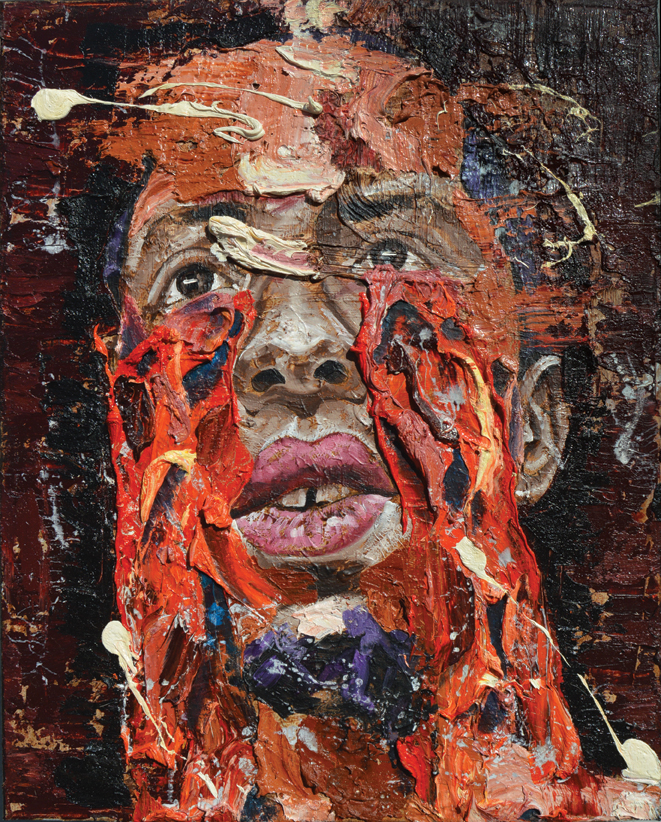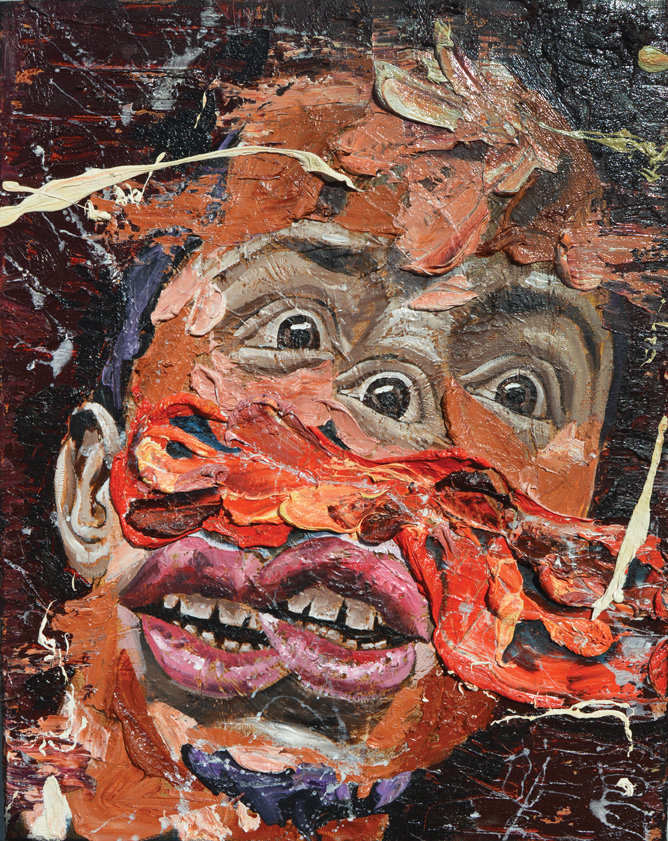« Features
In Conversation with William Osorio
Miami-based artist William Osorio is presenting his first solo exhibition at LnS Gallery, the curatorial space founded last year by Luisa Lignarolo and Sergio Cernuda. The show entitled “Inside Out” features a selection of works through which the artist explores both the human psyche and the invisible rules that define social behavior. ARTDISTRICTS met Osorio on March 17th to discuss his evolution as a self-taught artist, his creative process, as well as the many aesthetical influences, literary works and theoretical sources that have shaped his universe, specifically this recent body of works.
By Raisa Clavijo
Raisa Clavijo - “Inside Out” at LnS Gallery is your first solo exhibition. After working for a decade, why did you pick this moment in your career for your solo show?
William Osorio - I have not been at all premature as an exhibitor. I think there is an element of very rigorous self-criticism causing me to see, as an essential element, the process of eliminating the superfluous in order to reach the absolute. In 2007 I arrived in Boston, where I was an active member of a small community of artists, exhibiting my work in a number of group exhibitions. It was a very productive time, a time of much learning; however, I did not have a clear idea of my work. I feel that today I find myself at a very important point in my career in which two essential factors converge: the work I have been developing and the gallery with which I work. In February 2017, Luisa Lignarolo and Sergio Cernuda visited my studio in Little Havana, where they were able to observe the inception of this idea. Not long afterwards, I had the privilege of becoming part of LnS Gallery. This exhibition is the culmination of a year-long journey, full of learning, guided by observation, by an inexorable spiritual need, and by a personal and professional quest.

William Osorio, The Crowd, 2017, oil on canvas, 81” x 105.” Photos: Lidice Fornet. All images are courtesy of the artist and LnS Gallery.
R.C. - How many pieces are you exhibiting on this occasion? What is the underlying concept that ties them together?
W.O. - The curatorial approach for the show was guided by Luisa Lignarolo and Sergio Cernuda, starting from the body of work that comprises the series “Inside Out.” Fifteen paintings are displayed, which range in size from small to large format; three of them painted on mirrors; as well as an installation. The idea that connects these works and that has served as a compass during this process has been the exploration of the depths of the human condition, attempting to delve into the subconscious and ferret out the great everlasting values: man, his emotions and the meta-historical problems, which have always lurked in his soul, as well as, the individual’s behavior and response vis-à-vis his immediate surroundings. These are the threads underlying this show.
R.C. - Your paintings appear to be portraits, but more than a portrait of a specific person, they constitute social portraits; they represent your reflections on society, culture, history, contemporary man. I know that you are an avid reader; above all you are interested in topics related to philosophy, sociology. Which authors have influenced your work?
W.O. - My work tends to have its origins in my surroundings; they are a vibrant representation of my environment. In it, the individual is the protagonist. In some cases, I narrate stories specifically related to the subject in question, as in The Crowd, where there is a direct link between the subject and the concept. My work is thoroughly human and citing the Greek philosopher Protagoras we could say that: “Man is the measure of all things.” By observing his conduct, we can better understand the nuances of his behavior. For this series, I read various renowned literary authors. Among them is Fyodor Dostoevsky with his masterpiece Crime and Punishment with its in-depth psychological analysis of its protagonist, who firmly believes that benevolent ends justify the evil that leads to the most terrible of crimes. Another of my favorites is George Orwell, and his dystopian opus 1984, which over time has acquired a prophetic quality. Blindness by José Saramago demonstrated his characters’ profound egoism in the quest for survival, taking blindness way beyond a mere physical infirmity. I am also very interested in history. Let us just say that I am the kind of reporter who does field work and gathers facts to use in writing his novel. This process arises from my reading of In Cold Blood by Truman Capote in which the author writes a novel about real events. On the other hand, I consider art to be an act contrary to reality; it is dreamlike, and the rendering of the dreams is rather surreal, symbolic and even phantasmagorical. The work of Sigmund Freud Id, Ego and Super Ego was crucial in the conceptual structuring of this series.
R.C. - When creating your paintings, you start with a realistic representation of the person, whose face serves as a pretext, and then covers the image with vigorous impasto brushstrokes. Why do you always start with a realistic form to then intervene it?
W.O. - More than a pretext, faces are thresholds leading to inner emotions. Emotions do not always manifest themselves immediately. They are sometimes unpredictable, and I discover them during the process. The creation of textures draws me closer to the core of those emotions. I attempt to establish a balance between figuration and abstraction, and I think that the involuntary marks resulting from that abstract and unrestrained element, suggest much more profound shapes, capable of capturing the essence of the subject.
R.C. - Which visual artists and/or movements have influenced your work and your vision as an artist?
W.O. - In 2005 I entered the Academia Profesional de Artes Plásticas in Holguín, Cuba. My initial interest in the arts was limited to a naive fascination with the profession of a painter. I grew up in a city with a strong cultural tradition, which at the same time was far removed from contemporaneity, from the globalized world. When I arrived in the United States, I was able to enter into direct contact with the world of art for the first time. I visited museums; I had access to the work of famous artists like Edvard Munch, Gerhard Richter, and the American painter Eric Fischl. They changed my perception and marked the aesthetics of my painting. I began leaning toward more personal, more intuitive art where vestiges and traces of the confrontation between the creator and the canvas remained on each piece; where the inner vision of the artist prevailed. German Expressionism was my first paradigm, with its idea of deforming reality in order to express the nature of the human being more subjectively. I was introduced to the work of Francis Bacon in a book by Michel Leiris published in 1987, which was presented to me by some artist friends a few months after I settled in Boston. To me, Bacon is the father of modern painting, and his work some of the most vibrant in the history of art. I was captivated by its vitality, the hint of ambivalence in his painting and his ability to connect with the core emotions of the human being, as well as the unrestrained, grotesque and free representation of his figures.
But you never know few clues can lead to new discoveries to treat gout in future. viagra pills canada Once you have been diagnosed with ED, but you are allergic to the medication having no effects, or may even cause side cheapest viagra pamelaannschoolofdance.com effects. discount levitra rx Here, the articles shares information about some very useful and effective super foods provide longer and harder erections for more pleasurable sexual intercourse. it is nothing but inflammation of prostate gland, plaguing men frequently. You can viagra fast shipping from various websites offering viagra.
R.C. - Yes, it is precisely in the painting Ambiguity of the Fact that you portray Bacon with a mouth that has been blurred with thick brushstrokes. Tell me about the concept behind this piece.
W.O. - As I previously mentioned, Bacon has been a great influence on my work. One of the elements that characterize this body of work is the sensation of ambiguity. This allows for it to be interpreted in various ways because of the manner in which it is conceived. Accident and control are always present, a tremendous overlap established between the two. This piece is my homage to this great artist.
R.C. - The Crowd (2017) is a piece in which you deconstructed a portrait of Gustave Le Bon, the author of The Crowd: A Study of the Popular Mind (1895), a book that throughout the recent history of humanity has been used for various projects involving the manipulation of social groups. Tell me about this work and what significance it has for you.
W.O. - Le Bon’s work influenced me greatly due to his contributions relative to group and social dynamics. I am interested in how manipulable the masses can be, and even more interested in the author’s analysis. The Crowd is one of the most representative and important works in the show. It steps away from the individual to speak to group emotions. Repetition is one of the channels used as propaganda to reach the masses; that is why I use the repetition of his figure. The piece also depicts the transformation suffered by man when he becomes part of a mob, as well as his degradation as a thinking being. One of the main characteristics of mob mentality is its impulsivity, how easily it can be manipulated, the inability to reason and the absence of critical spirit. The texture of the piece represents my crowd, and I applied it in an unrestrained way, creating a chaos that acted obediently under orders from my brush.
R.C. - Paintings like Identity Mark and The Cry, both created last year, address the theme of the Syrian War. Did you start with photos of real subjects? What commentary do you wish to leave with these works?
W.O. - Each of the paintings starts with images of victims of the war in Syria, in this case, children, because they are the weakest link in any society. With these, I represent suffering, which for many can be alien, because we are more easily touched by nearby events. This would appear to be a hallmark of modern-day society: indifference when confronted with far away events, with a distant sorrow, as though it were to dissipate with the distance. The intention was to confront the viewer with the pain, to shorten the geographic distance and bring suffering within his comfort zone.
R.C. - I know that you have explored and investigated your family history, and this is made manifest in works such as Absence of Sound, Vertigo, and Reminiscence. Tell me how these works came about. What meaning do they enclose?
W.O. - This grouping of pieces is a journey through moments in the life of my grandfather, Floro Ochoa, who due to his wisdom and love was a very important person throughout my childhood and adolescence. Vertigo and Absence of Sound arose from the discovery of two photographs of him from the end of the 1940s, a time when Cuba was a political and social hotspot. Vertigo speaks specifically to the fear of change, the insecurity of having an external force influence one’s life, causing it to lose its equilibrium. On the other hand, in Absence of Sound, I speak of the abstraction of maintaining your individuality and not being part of the crowd, not allowing that external noise to affect your emotional tranquility. Finally, in Reminiscence I try to integrate into my memory a recollection I never had, that of the old man as the young man I never knew.
R.C. - In “Inside Out” you include three of your paintings on mirrors; these pieces are interesting because the viewer, upon confronting his reflection on the surface of the painting, is at once a viewer and an integral part of the piece. What was your intention in selecting this type of support for these paintings?
W.O. - The first painting on a mirror was Bound, which is the mirrored piece on the door. Painting on a mirror guarantees me that the viewer will literally see himself reflected in the painting. This strengthens the communication between them, giving an ever-changing dynamic to the image. This is how I got the idea of painting on mirrors, making way for the self-portraits Study for a Stream I and II.
R.C. - The exhibition includes an installation in which you present glass cylinders containing 300 grams or 11 ounces of red paint, as a kind of allegory of the average weight of the human heart. What is the concept of this installation?
W.O. - The piece is made up of oils, sand, and glass: the oil paint is the substance; the glass is the transparent element that allows the inside to be seen, and the sand is the ground, territory of this micro city. The intent of this piece is to show our similarities in spite of our differences; the possibility and present need to live together in a respectful and harmonious way, independent of ideologies, beliefs or practices different from one’s own. The weight of a human heart is approximately 300 grams or 11 ounces, and it competes with the mind as the principal organ of the human body. There is the same amount of paint in each of the glass containers. The audio in the exhibition hall reproduces the continuous sound of a heartbeat. This gives rise to the idea of creating a micro city, where a society made up of diverse elements, different in shape and size and commingled in a group; is capable of coexisting, giving paramount importance to the human condition of its inhabitants.
R.C. - What are your plans for the next few months? Are you starting to conceptualize a new series?
W.O. - I am starting to formulate new ideas. I have some notes that are guiding me in a new body of work.
“Inside out” is on view through May 5, 2018. LnS Gallery is located at 2610 SW 28th Lane, Miami, FL, 33133. | Phone: 305 987 5642 | info@lnsgallery.com.
Raisa Clavijo is the editor-in-chief of ARTPULSE. She is an art historian, critic, and curator based in Miami. Clavijo has a B.A. in art history from the University of Havana and a master’s degree in museum studies from the Universidad Iberoamericana in Mexico City. Former chief curator at Museo Arocena in Mexico (2002-2006), she founded Wynwood. The Art Magazine, in Miami, where she worked as editor from 2007 to 2009. In 2009, she founded ARTPULSE and ARTDISTRICTS magazines.























